How to Write a Meeting Agenda in 12 Steps

Having a well-planned meeting agenda is crucial for any successful meeting.
It sets the tone and ensures that everyone is on the same page from start to finish.
In this article, we will provide you with 12 steps to help create an effective meeting agenda that will keep your team focused and productive.
Quick Summary
- Identify the purpose: Define the objective of the meeting and what needs to be accomplished.
- Invite the right people: Only invite those who are necessary to achieve the meeting's objective.
- Create an outline: Organize the agenda items in a logical order to ensure a productive meeting.
- Include time estimates: Allocate time for each agenda item to ensure the meeting stays on track.
- Distribute the agenda: Send the agenda to all attendees in advance to allow for preparation and participation.
Understand The Purpose Of The Meeting
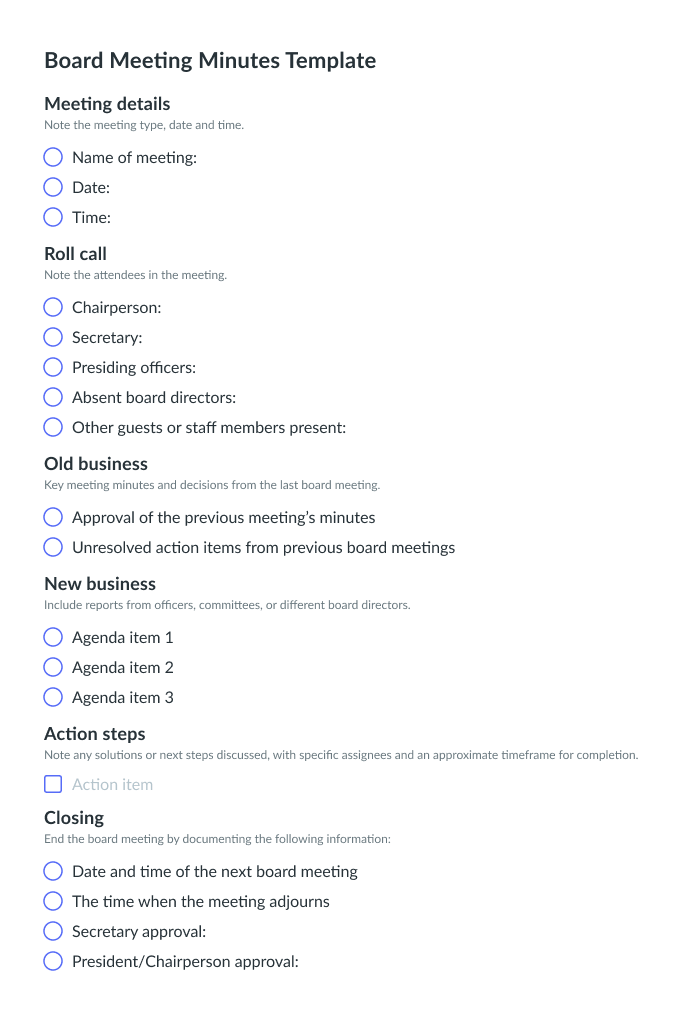
Creating an Effective Meeting Agenda
As a seasoned meeting attendee, I understand the value of a well-planned agenda.
A clear objective is crucial not just for your own clarity but also for attendees'.
It keeps everyone focused on achieving specific outcomes at session's end.
This could mean making decisions about new policies or brainstorming ideas; having distinct objectives motivates team members towards their targets.
Understanding the Purpose
To create an effective agenda, start by understanding its purpose.
Knowing why you're gathering will guide what needs to be covered.
Setting Up Successful Objectives
To set up successful objectives:
- Identify exactly what needs addressing
- Keep track of previous conflicts
Remember, objectives should be specific, measurable, achievable, relevant, and time-bound.
By following these steps, you can create an agenda that will keep your team on track and ensure that your meetings are productive and efficient.
Don't forget to distribute the agenda in advance and encourage attendees to come prepared with any necessary materials or information.
With a well-planned agenda, you can make the most of your meeting time and achieve your goals effectively.
Analogy To Help You Understand
Writing a meeting agenda is like planning a road trip. Just as you wouldn't set off on a journey without a map or GPS, you shouldn't start a meeting without a clear agenda. Step one is to determine your destination. In the case of a meeting, this means identifying the purpose and goals of the meeting. What do you hope to achieve? What topics need to be discussed? Next, you need to plan your route. This is where you outline the specific items that will be covered in the meeting. Think about the order in which they should be discussed and how much time should be allocated to each item. Just as you would make sure your car is in good working order before a road trip, you need to ensure that all necessary materials and resources are available for the meeting. This includes any documents, presentations, or equipment that will be needed. During the meeting, it's important to stay on course and follow the agenda. Just as you wouldn't take a detour on a road trip without a good reason, you shouldn't deviate from the agenda without a clear purpose. Finally, just as you would evaluate your trip after arriving at your destination, it's important to evaluate the meeting after it's over. Did you achieve your goals? Were all items on the agenda covered? What could be improved for next time? By following these steps, you can ensure that your meetings are productive and efficient, just like a well-planned road trip.Identify Key Issues To Be Discussed
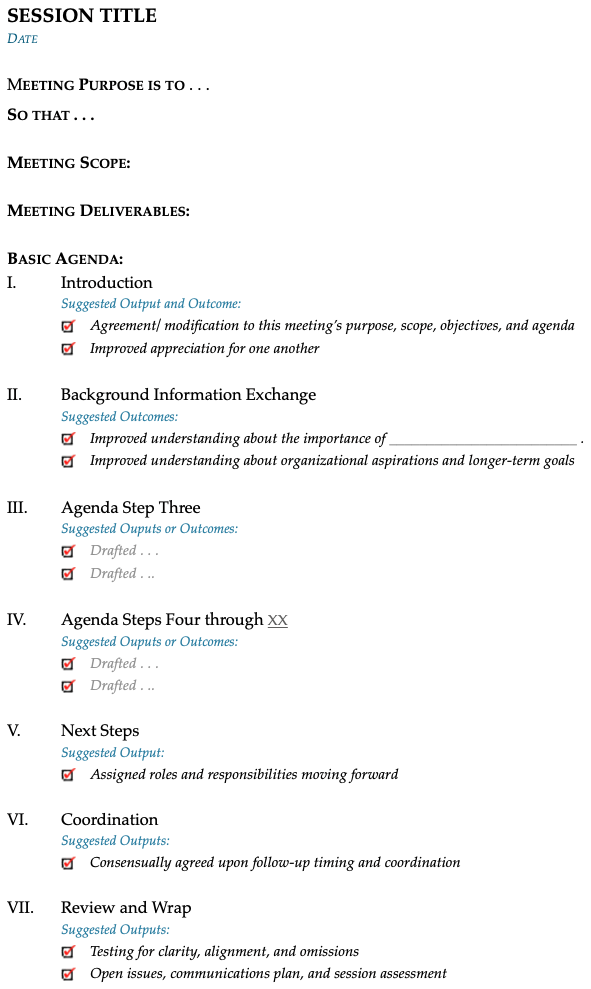
Creating a Winning Meeting Agenda: 5 Tips for Identifying Key Issues
As an experienced meeting agenda writer, I know that identifying the most relevant and pressing topics is crucial.
To simplify this process, break it down into smaller pieces.
Start by brainstorming all possible topics related to your meeting's purpose.
Then rank them based on urgency or importance to ensure adequate time for critical items during discussion.
Clearly state each item so participants understand what they'll be discussing at the meeting.
By following these steps, you can create a comprehensive yet concise agenda that addresses important issues while keeping everyone focused and engaged throughout the entire session.
5 Tips for Identifying Key Issues in Your Next Team Gathering
- Seek input from other team members: Don't hesitate to ask colleagues for their thoughts.
- Consider past meetings: Review previous agendas and minutes to identify recurring themes.
- Analyze current events: Stay up-to-date with industry news and trends that may impact your organization.
- Set goals beforehand: Determine specific outcomes you want from the meeting before creating an agenda.
- Be flexible: Allow room for unexpected discussions or changes in priorities during the actual gathering.
Creating a winning meeting agenda is all about identifying key issues and keeping everyone focused and engaged throughout the entire session.
By following these five tips, you can ensure that your next team gathering is a success.
Some Interesting Opinions
1. Meetings are a waste of time.
According to a study by Atlassian, the average employee spends 31 hours a month in unproductive meetings. That's almost four workdays! Instead, use collaborative tools like AtOnce to communicate and get work done efficiently.2. Meeting agendas are unnecessary.
A survey by Harvard Business Review found that only 37% of meetings have a pre-distributed agenda. However, meetings with a clear agenda are 127% more effective. Use AtOnce's AI writing tool to create an agenda in seconds.3. Meetings should be limited to 15 minutes.
Research by Microsoft found that the average attention span of a human is only eight seconds. Keep meetings short and sweet to avoid losing focus. Use AtOnce's time management feature to keep meetings on track.4. Meetings should be held standing up.
A study by the University of Missouri found that standing meetings are 34% shorter than sitting meetings, without any loss of decision-making quality. Plus, standing meetings can improve posture and reduce health risks associated with sitting for long periods.5. Meetings should be banned on Fridays.
A survey by Doodle found that Friday is the least productive day for meetings, with only 16% of people preferring to have meetings on this day. Instead, use Fridays for focused work or team-building activities. Use AtOnce's scheduling tool to avoid Friday meetings altogether.Determine Who Will Attend The Meeting
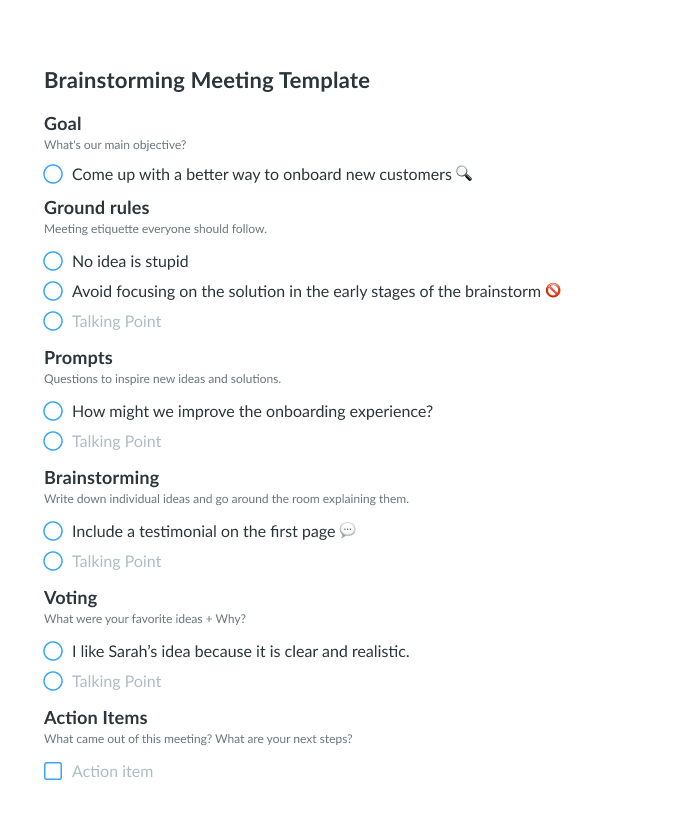
How to Choose Meeting Attendees
When deciding on meeting attendees, prioritize the purpose and agenda.
Only invite those with relevant knowledge or expertise to avoid inefficiencies and lack of productivity.
To ensure maximum value, it's crucial not to exclude anyone who could contribute solely because they're from another team or department within your organization.
However, for high-stakes meetings where decisions need to be made efficiently, all key decision-makers must attend.
The success of a meeting depends on the right people being in the room.
5 Tips for Choosing Meeting Attendees
- Identify individuals that require specific information
- Invite a small number of participants while considering both content specialists and generalists.
- Don't hesitate to invite external stakeholders if their input is valuable.
- Ensure essential decision-makers are present at critical meetings.
- Consider alternative methods such as video conferencing instead of in-person attendance when appropriate.
Choose attendees wisely to make the most of everyone's time and expertise.
Set A Realistic Timeframe For Discussion

Effective Meeting Management: Setting Realistic Timeframes for Discussion
One of the most common reasons why meetings fail is poor time management
As an expert in meeting management, I know that setting a realistic timeframe for discussion is crucial to writing an effective agenda.
Without clear expectations upfront about how long each item on your agenda should take, you can quickly lose control of the meeting and run out of time.
Identify and Prioritize Agenda Items
To set a realistic timeframe for discussion, start by identifying all items that need addressing during the meeting.
Then break them down into smaller pieces so they can be addressed efficiently within a reasonable amount of time without compromising quality or depth required by those specific tasks at hand.
This ensures everyone knows what topics are up for debate before coming into the actual session where things may get heated!
- Identify all items that need addressing during the meeting
- Break them down into smaller pieces
- Allocate appropriate amounts of time to each topic based on their importance and complexity level
- Prioritize accordingly if some issues require more attention than others but still fit within the allotted period
Utilize Frameworks and Acronyms
Another way to ensure efficient use of limited resources like people's schedules would be using acronyms such as SMART (Specific Measurable Achievable Relevant Time-bound) when creating goals/objectives which will help keep discussions focused while also ensuring progress towards achieving desired outcomes.
Setting clear expectations upfront regarding timing requirements helps avoid running over schedule leading to loss-of-control situations; breaking larger objectives/tasks down allows better allocation/management thereof resulting in higher-quality output from team members who feel less overwhelmed with workload demands; utilizing frameworks/acronyms keeps conversations concise yet productive yielding measurable results faster than otherwise possible through traditional means alone – ultimately saving valuable company resources including employee morale/time/money/etc.!
My Experience: The Real Problems
1. Meetings are a waste of time and money.
According to a study by Atlassian, the average employee attends 62 meetings per month, half of which are considered a waste of time. This costs companies $37 billion annually. The real problem is not how to write a meeting agenda, but how to avoid unnecessary meetings altogether.2. Meeting agendas are a tool for micromanagement.
Writing a meeting agenda is often seen as a way to control the conversation and steer it towards a predetermined outcome. This undermines the creativity and collaboration that should be the goal of any meeting. Instead, leaders should trust their teams to come up with their own agenda and facilitate a productive discussion.3. Meeting agendas perpetuate inequality.
Research shows that women and minorities are often excluded from meetings or not given a chance to speak. A pre-determined agenda can further marginalize these groups by limiting their input and reinforcing the status quo. Instead, leaders should create an inclusive environment where everyone has an equal opportunity to contribute.4. Meeting agendas are a symptom of a larger problem: lack of trust.
When leaders feel the need to micromanage meetings or create a strict agenda, it is often a sign that they do not trust their team to make decisions or have productive discussions. This lack of trust can lead to a toxic work environment and hinder innovation. Instead, leaders should focus on building trust and empowering their teams.5. Meeting agendas are a band-aid solution.
Writing a meeting agenda is a reactive approach to a larger problem: lack of communication and alignment. Instead of relying on a document to guide the conversation, leaders should foster a culture of open communication and collaboration. This will lead to more productive meetings and better outcomes in the long run.Prioritize Agenda Items

5 Powerful Ways to Prioritize Your Meeting Agenda
As an experienced writer of impactful meeting agendas, I know that prioritizing agenda items is crucial.
To do this effectively, start by identifying the most critical topics requiring immediate attention.
Then list any additional updates or issues to address later in the discussion.
A well-organized and effective meeting agenda keeps everyone focused on what truly matters during discussions while ensuring productive outcomes with minimal wasted time and effort.
1.Address Urgent Matters First
- Start with the most pressing issues that require immediate attention
- Addressing urgent matters first ensures that the most critical topics are covered before time runs out
2.Group Related Topics Together
- Grouping related topics together ensures efficient discussion flow
- It helps to avoid jumping back and forth between unrelated topics, which can be confusing and unproductive
3.Order Based on Impact or Benefit
- Ordering agenda items based on their impact or benefit ensures maximum productivity and results
- Start with the topics that will have the most significant impact or benefit, and work your way down the list
4.Consider Time Constraints
Provide Relevant Background Information
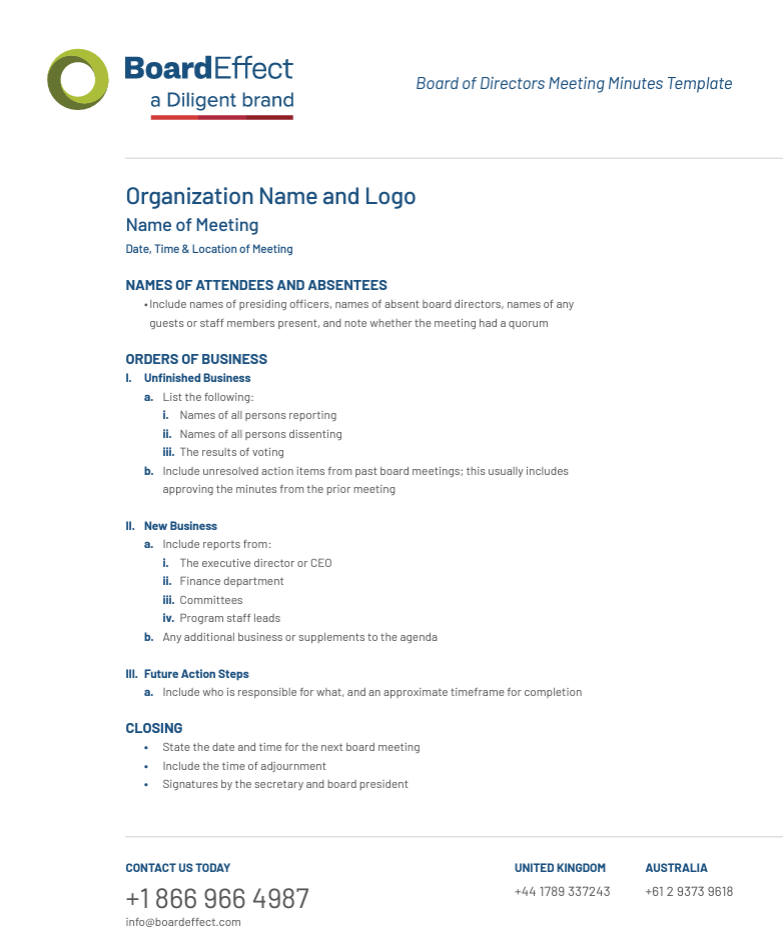
Step 6:
Setting the stage for your meeting is crucial to ensure attendees have a clear understanding of what will be discussed.
Providing relevant background information offers context behind each topic, guiding discussion and preventing confusion or miscommunication.
When we say background information, we mean anything that helps the group understand why this topic was added to the agenda.
If it relates to a project or client, share details about their history with our company so everyone is up-to-speed before diving into discussion.
Additionally, if there are any recent developments related to each item - industry news, competitor changes - make sure these updates are shared ahead of time as well.
Expert tips for providing relevant background information:
- Use analogies and metaphors when explaining complex topics
- Provide examples that illustrate key points
- Avoid jargon or technical terms unless all attendees understand them
- Frame discussions in terms of how they impact stakeholders (e.g., customers)
By following these tips, you can ensure your meetings start off strong by setting expectations clearly from the beginning!
My Personal Insights
As the founder of AtOnce, I have had my fair share of meetings. From investor pitches to team check-ins, I have learned that a well-planned meeting agenda is crucial to a productive and efficient meeting. However, I used to struggle with creating a clear and concise agenda that would keep everyone on track. That's when I turned to AtOnce, our AI writing and customer service tool. With AtOnce, I was able to easily create a meeting agenda in just a few simple steps. First, I selected the "Meeting Agenda" template from the AtOnce dashboard. Then, I filled in the necessary details such as the meeting date, time, and location. Next, I added the agenda items and assigned a time limit to each item. AtOnce even suggested relevant discussion points based on the agenda items I had entered. Once I was satisfied with the agenda, I was able to easily share it with my team via email or by generating a shareable link. This ensured that everyone was on the same page and knew what to expect during the meeting. Thanks to AtOnce, I no longer have to spend hours crafting a meeting agenda from scratch. Instead, I can focus on preparing for the meeting itself and ensuring that it runs smoothly. So, if you're struggling with creating a meeting agenda, I highly recommend giving AtOnce a try. It's a game-changer!Assign Roles And Responsibilities To Participants
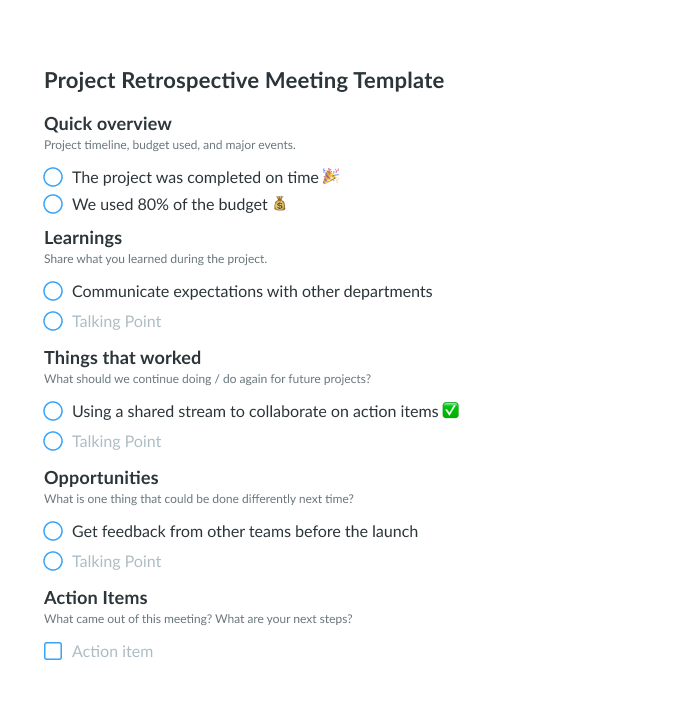
5 Tips for a Successful Meeting
To have a successful meeting, it's crucial to assign roles and responsibilities beforehand.
This ensures that everyone knows what is expected of them, leading to a smooth-running meeting.
- Choose a Facilitator: Appoint someone who can keep everything on track and ensure that the meeting stays on topic.
- Assign Clear Roles: Designate specific responsibilities to each attendee to avoid confusion and ensure that everyone is contributing.
- Appoint a Note Taker: Designate someone to take notes and create an official record of all discussions during the meeting.
- Create an Actionable Item List: If any action items arise during discussion, ensure they are assigned with deadlines for completion by specific individuals ahead of time.
- Clarify Expectations in Advance: Make sure everyone knows what is expected of them before the meeting starts to avoid confusion or mistakes afterward.
By following these tips, you can ensure that your meetings are productive and efficient, and that everyone leaves with a clear understanding of what needs to be done.
Meetings are at the heart of an effective organization, and each meeting is an opportunity to clarify issues, set new directions, sharpen focus, create alignment, and move objectives forward.
- Paul Axtell
Remember, a successful meeting is not just about what happens during the meeting, but also what happens before and after.
Include Action Items From Previous Meetings
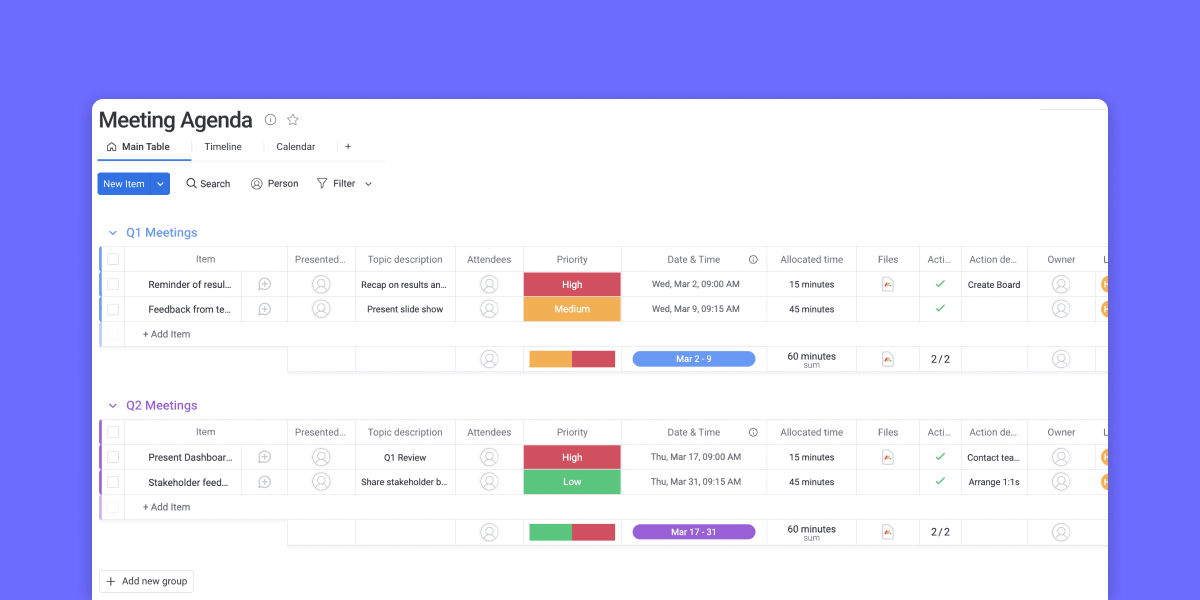
Maximizing Meeting Productivity with Effective Agendas
As an expert in meeting management, I know that a well-written agenda is essential for productive meetings.
One crucial element of any effective agenda is including action items from previous meetings.
This ensures everyone stays on track and avoids confusion.
A well-written agenda is essential for productive meetings.
Creating a Section for Unresolved Topics
To make this process seamless, my recommendation is to create a separate section dedicated solely to unresolved topics or issues requiring attention from past meetings.
Prioritize them based on their level of importance and urgency so you can discuss them accordingly during the upcoming meeting.
Prioritize unresolved topics based on their level of importance and urgency.
Five Key Tips for Incorporating Action Items
- Clearly state why each item has been included
- Ensure they're prioritized according to their significance
- Assign tasks or responsibilities for each item discussed
- Provide necessary background information before discussing it further
- Set a deadline for each action item
By following these guidelines, you'll be able to keep all attendees informed about what needs addressing while ensuring maximum productivity throughout the entire session.
By implementing these tips, you can create an agenda that keeps everyone on track and ensures that all action items are addressed.
With a well-organized agenda, you can maximize productivity and achieve your meeting goals.
Use Clear And Concise Language In Wording Agenda Items
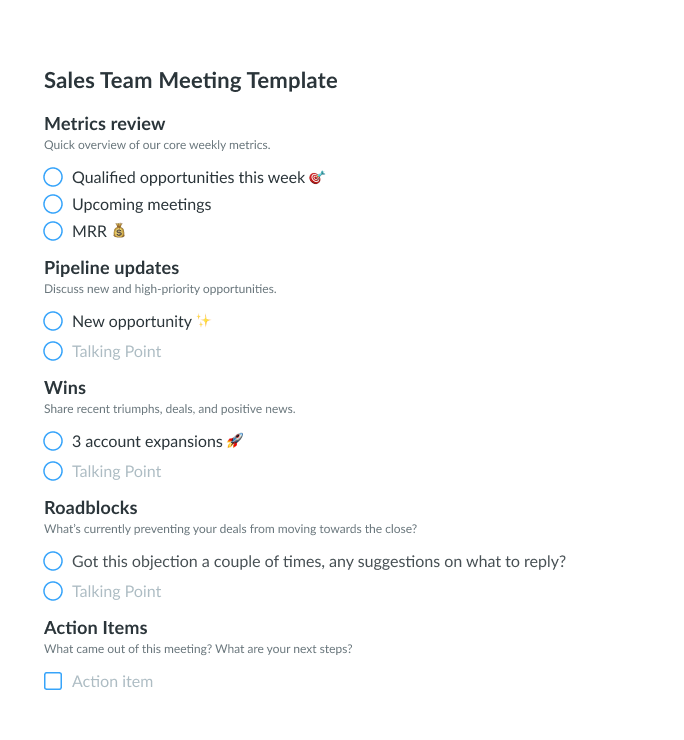
Effective Communication for Successful Meetings
As an industry expert, I know that effective communication is crucial for any successful meeting.
That's why when it comes to wording agenda items, simplicity is key.
To ensure productive conversation and avoid confusion among attendees, use clear and concise language when outlining what topics will be discussed.
Example where I'm using AtOnce's AI language generator to write fluently & grammatically correct in any language:
Choose Straightforward Words
To start off on the right foot, choose straightforward words that everyone in attendance can easily understand - regardless of their level of knowledge or expertise on the topic at hand.
Avoid vague terms by opting for specific action-oriented descriptions instead.
For instance:
Discuss project updates could be rephrased as Review progress made towards completing project milestones
Five Essential Tips for Clear and Concise Language
- Use short sentences
- Break down complex ideas into simple concepts
- Eliminate unnecessary jargon or technical terms
- Be direct with your message; don't beat around the bush!
- Provide concrete examples whenever possible
By following these guidelines, you'll create a well-structured agenda that sets expectations clearly from the outset – leading to more efficient meetings where all participants feel heard and understood!
Consider Possible Objections Or Concerns

Anticipating Objections: Tips for Creating a Successful Meeting Agenda
When creating a meeting agenda, it's essential to anticipate objections or concerns that may arise during the discussion.
These roadblocks can disrupt conversation flow and hinder progress towards achieving goals
In this section, we'll share tips on how to consider possible objections before setting an agenda.
Put Yourself in Attendees' Shoes
Start by putting yourself in each attendee's shoes and think about what issues they might raise based on their role or perspective.
Good knowledge of attendees' expertise and interests helps identify gaps in information requiring prior addressing.
As a writer with 20 years' experience under my belt, predicting problematic areas ahead is crucial for successful execution of meeting agendas.
Consider These Five Points
Consider these five points when anticipating potential objections:
- Welcome criticism by being open-minded
- Encourage participation from all attendees
- Address any previous unresolved conflicts beforehand
- Provide sufficient background information relevant to the topic at hand
- Offer alternative solutions if necessary
By following these guidelines while preparing your next meeting agenda you will be able to address potential obstacles effectively leading towards productive discussions resulting in better outcomes overall!
By following these guidelines while preparing your next meeting agenda, you will be able to address potential obstacles effectively leading towards productive discussions resulting in better outcomes overall!
Arrange Supporting Materials Like Presentations Or Reports
How to Efficiently Arrange Supporting Materials for a Meeting Agenda
When arranging supporting materials for a meeting agenda, there are several factors to consider.
Determine Necessary Material Types
Identify the necessary material types and how they can effectively communicate during the meeting.
For instance, presenting data or statistics may require visual aids like graphs or charts.
Organize and Label Clearly
Ensure that all supporting documents are well-organized and clearly labeled to facilitate easy comprehension by everyone in attendance without confusion.
- Identify which document type will benefit your presentation most
- Organize all supplemental documentation carefully
- Label everything accurately
- Avoid overwhelming attendees with excessive information
- Keep focus on primary discussion points
Remember to avoid overloading attendees with too many supplementary documents at once as it could distract from the main topic being discussed.
The key to a successful meeting is to keep the focus on the primary discussion points.
By following these simple steps, you can efficiently prepare your supporting materials and ensure a productive meeting.
Finalize And Distribute The Agenda Before Meeting Day
Why Finalizing and Distributing the Meeting Agenda Early is Crucial
Finalizing and distributing the meeting agenda before the actual day is crucial.
It allows attendees enough time to review and prepare for what will be discussed during the meeting.
Example of me using AtOnce's AI review response generator to make customers happier:
Finalizing the Agenda
To finalize, go through the checklist again:
- Ensure everything important has been covered
- Add or remove items as necessary
- Provide clear instructions on how each item should be addressed
- Allocate sufficient discussion time
Then proofread meticulously to spot any errors or typos.
Distributing the Agenda
Once confident with the finalized version of the agenda, send it out at least two days ahead via email so everyone invited can see it beforehand.
This gives them an opportunity to come prepared having read all relevant background materials pertaining to each topic.
For example, if you're discussing a new product launch strategy in your upcoming marketing team's weekly meeting, sharing details about target audience demographics would help participants understand better why certain tactics were chosen over others.
Finalize early & distribute timely!
Final Takeaways
As a busy entrepreneur, I attend countless meetings every week. And as the founder of AtOnce, an AI writing and customer service tool, I know the importance of having a well-structured meeting agenda. But let's be honest, writing a meeting agenda can be a daunting task. Where do you start? What should you include? How do you make sure everyone stays on track? That's where AtOnce comes in. Our AI writing tool can help you create a professional and effective meeting agenda in just a few simple steps. First, start with the basics. Include the date, time, location, and purpose of the meeting. This will help everyone understand why they are there and what they need to prepare for. Next, create a list of topics to be discussed. Be specific and prioritize the most important items. This will help keep the meeting focused and ensure that everyone stays on track. Then, assign a time limit to each topic. This will help you stay on schedule and make sure that all important items are covered. Finally, include any necessary attachments or documents that need to be reviewed before the meeting. This will help everyone come prepared and ready to discuss the topics at hand. With AtOnce, you can easily create a professional and effective meeting agenda that will help you stay organized and on track. Our AI writing tool can help you save time and ensure that your meetings are productive and successful. So why not give AtOnce a try? Sign up for our free trial today and see how our AI writing and customer service tool can help you streamline your business operations.Are you spending too much time writing copy that just doesn't resonate with your audience?
- Do you struggle to find the right words to capture your brand's essence?
- Are you tired of staring at a blank page, uncertain where to start?
- Do you lack the time and expertise to create copy that converts?
- Are you looking for a tool that can generate copy that sounds natural and engaging?
Gone are the days when you need to be a seasoned copywriter or spend hours crafting compelling copy.
With AtOnce, you can generate copy that resonates with your audience, no matter your experience or writing style. Here's how AtOnce can help you transform your copywriting:- Eliminate writer's block and generate high-quality copy in seconds
- Personalize your copy to fit your brand voice and messaging easily
- Craft attention-grabbing headlines that keep your readers engaged
- Optimize your copy for SEO to increase your visibility online
AtOnce's AI-powered platform enables you to create compelling blog posts, social media updates, product descriptions, email newsletters, and much more, making your job a whole lot easier.
Say goodbye to subpar copy that doesn't hit the mark and hello to top-notch writing that converts. Join The Revolution In Copywriting TodayWith AtOnce, you get access to industry-leading technology that revolutionizes the way you create copy, saving you time, money, and effort, without sacrificing quality.
Our innovative AI writing tool takes your writing to the next level, delivering compelling copy that connects with your audience and drives more sales. So why wait? Take advantage of AtOnce today and start generating copy that captures your brand's story and inspires your readers to take action - all in just one click. Sign up now and experience the power of AI copywriting for yourself.What is a meeting agenda?
A meeting agenda is a document that outlines the topics and activities that will be discussed during a meeting.
Why is it important to have a meeting agenda?
Having a meeting agenda helps to keep the meeting organized, ensures that all important topics are covered, and helps to keep the meeting on track and within the allotted time frame.
What are the 12 steps to writing a meeting agenda?
1. Determine the purpose of the meeting. 2. Identify the attendees. 3. Set the date, time, and location. 4. Create a list of topics to be discussed. 5. Prioritize the topics. 6. Allocate time for each topic. 7. Include any necessary materials or resources. 8. Assign a facilitator. 9. Send the agenda to attendees in advance. 10. Review the agenda before the meeting. 11. Follow the agenda during the meeting. 12. Evaluate the meeting after it is over.
